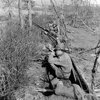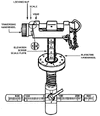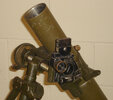Interesting in depth discussion of use of individual and crew served weapons in Italy during WWII.
Uphill All The Way: The U.S. Army In The WWII Italian Campaign
Uphill All The Way: The U.S. Army In The WWII Italian Campaign

As an old 112.70, I found the use of the Ma Deuce as an indirect fire weapon of interest.The use of the .50 Cal. guns in harassing the enemy proved very effective in that it restricted his movements on trails and roads and prevented him from supplying his troops with ease or security. In some instances MGs were placed in the second story of a building away from the door or window and sandbags used to give them a firm base. A blanket or burlap was used to screen the opening so that the smoke and flash would not disclose the gun position. Range cards were accurately prepared for each MG position, and each key man had a copy.
If properly set-up, the tripod with a Traverse & Elevation mechanism is fairly robust, and capable of 1 mil adjustments. A forward observer would not be required, as all the elevation and azimuths would be recorded on the range card, so at night in in fog would can still drop rounds on a target. For example, if the range card had:As an old 112.70, I found the use of the Ma Deuce as an indirect fire weapon of interest.
I cannot see any special sight on the MG other than the original direct fire sights, and the ground mount tripod appears to be the standard mount. They mention use of range cards, which would suggest an FO would be necessary, but I wonder how precision IDF can be accomplished w/the weapon pictured.
Did a little research on MG IDF and all I was able to uncover was a training film on the old M1917 Browning WC MG which was equipped w/special ground mount which was adjustable for extreme elevation and windage.
Never fired the 1917, but have fired the M1919 from both a ground mount which, due to the limited travel of elevation mechanism would not be suitable for IDF and a pedestal mount which had no elevation or windage mechanism.

Thank you, sir. This is the information I was hoping for. I can't see the T&E in the picture and its been a long time since I fired the M1919 from ground mount. Did nor recall the T&E mechanism; your picture refreshed my memory.If properly set-up, the tripod with a Traverse & Elevation mechanism is fairly robust, and capable of 1 mil adjustments. A forward observer would not be required, as all the elevation and azimuths would be recorded on the range card, so at night in in fog would can still drop rounds on a target. For example, if the range card had:
Bridge - LT 157 - UP 83

Well if you (the gunner) can't actually see the target, you will have to use indirect fire methods to establish the azimuth and elevation. But, that is dead simple, just fire a burst of tracer and an observer calls back corrections, repeat until the rounds land on the desired target. For multiple targets, just write down multiple target data.Thank you, sir. This is the information I was hoping for. I can't see the T&E in the picture and its been a long time since I fired the M1919 from ground mount. Did nor recall the T&E mechanism; your picture refreshed my memory.
I am still having a hard time w/procedure for setting up a MG for indirect fire. Understand azimuth for windage, but how is the elevation setting determined w/o an FO, especially w/multiple targets?
Mortar ammo comes w/card showing charge and elevation settings, measured with (way back when) the M4 sight pictured below. An aiming stake is set up on proper azimuth, determined by an FO or plotted on map by the FDC. Once range and azimuth is determined it was still necessary to consult range card for the chosen ammo for elevation settings and increment charge for given range.
Elevation is set on the sight, then tube adjusted to level the bubble on sight w/elevation screw on bipod then aimed at the stake using traversing mechanism on bipod. This gets you close, but the FO then relays corrections to insure rounds hit within bursting radius of ammo used.
Thanks again, lysanderxiii !


That is sophisticated.The German Laffette tripod was even more sophisticated, as you could set it up to automatically traverse and search the beaten zone using the guns recoil to incrementally shift azimuth until it hit a stop, when it would reset like a typewriter. They also had a periscope sight that could be used as a panoramic sight for indirect fire.

Did you mean smaller than an office building?Hitting anything bigger than an office building with a Caliber .50 ...
Did you mean smaller than an office building?
@Mal H DittoBy the way, Mal H, thanks for reviving this thread.
Think I have that book; will have to dig through my library and see. THXThere is a short but excellent discussion of the use of machine guns as indirect fire weapons in WWI in the book "A Rifleman Went To War" by Herbert W. McBride.
